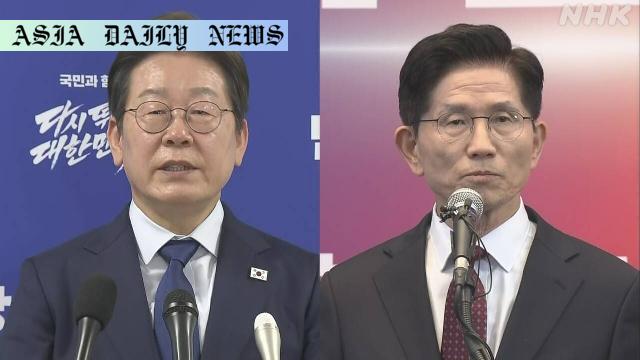Election: The latest Gallup Korea poll shows the gap narrowing between Lee Jae-myung and Kim Moon-soo ahead of the June 3 election.
The gap between South Korea’s two leading presidential candidates has tightened significantly.
Lee Jae-myung leads at 45%, while Kim Moon-soo follows at 36% as per the Gallup Korea poll.
Lee Jun-seok from the New Reform Party has shown a 2% point rise to 10%.
47% of independent voters remain undecided as June 3 approaches.

Introduction: A Race Tightens Ahead of the Election
The South Korean presidential election, scheduled for June 3, has entered a heated stage as the gap between the top candidates narrows considerably. According to a Gallup Korea poll released last Friday, opposition Democratic Party candidate Lee Jae-myung remains the frontrunner with 45%, while his main rival, Kim Moon-soo of the ruling People Power Party, has risen significantly to 36%. Compared to last week’s gap of 22 percentage points, this week’s poll indicates a closer, nine-point difference. This shift, taking place just 10 days before the election, could dramatically impact the final outcome as campaigning intensifies.
Analyzing the Poll Results
In the latest survey involving 1,002 respondents conducted over three days, notable trends have emerged. Lee Jun-seok, from the minor conservative New Reform Party, has climbed to 10%, reflecting a modest 2% rise compared to last week’s numbers. This growth could indicate a redistribution of support within the conservative electorate, adding complexity to the ongoing dynamics between the major contenders. Additionally, nearly half (47%) of undecided voters—individuals without clear party affiliations—highlight the unpredictable nature of the electorate. With slightly over one week left before the election, the volatility of voter alignment may be a decisive factor in determining the next leader of South Korea.
The Role of Strategic Alliances
One significant element shaping the election’s outcome is the possibility of strategic alliances between parties. Lee Jun-seok, despite his minor party’s position, holds a critical 10% of the vote which could serve as a crucial swing toward either the conservative or opposition bloc. However, Jun-seok has dismissed speculation of a potential withdrawal from the race to consolidate conservative forces. By remaining steadfast in his candidacy, Jun-seok introduces an additional layer of uncertainty and may create fragmented voter blocs that weaken a single majority path. His decision underscores a broader trend in South Korean politics, where smaller parties are beginning to exert more influence in traditionally two-party dominant systems.
Implications for Democracy and Voter Behavior
This election could set a precedent not only for the immediate political future but also for South Korea’s democratic norms. A narrowing gap signals that candidates are engaging in competitive campaigns designed to resonate deeply with voters’ concerns. Economic challenges, security tensions in the Korean Peninsula, and broader concerns about governance are likely shaping voter sentiment. How each party addresses these issues could have significant ramifications, not just on the domestic stage but also in shaping South Korea’s global stance. The role of undecided voters, in particular, remains pivotal as their eventual choices may lean based on last-minute developments in campaigning, media coverage, and leadership debates.
Looking Ahead: A Race Too Close to Call
The 2024 South Korean presidential election serves as a vivid display of how democratic processes remain dynamic and unpredictable in a rapidly changing world. As polling numbers narrow and new factors emerge, such as undecided voters and unyielding minor candidates, the race grows increasingly difficult to forecast. This moment underscores the importance of critical and participatory engagement by citizens, as well as transparent campaigning by parties. The coming days will likely witness heightened activity from candidates, each vying for the decisive sway of public opinion. Whichever path South Koreans take on June 3 will undoubtedly define not just the next five years of leadership but also the evolving contours of the nation’s democratic spirit.



Commentary
The Art of Political Momentum
The latest developments in South Korea’s presidential election highlight fascinating shifts in political momentum. With frontrunner Lee Jae-myung’s lead narrowing and Kim Moon-soo closing the gap from 22 to just 9 percentage points, the dynamics of this race are a compelling study in the unpredictability of modern politics. Such shifts often stem from strategic storytelling by campaigns, last-minute policy announcements, or unanticipated missteps by candidates. For voters, these changes amplify the stakes of paying close attention to every nuance during the election’s home stretch.
The Role of Undecided Voters
Perhaps the most intriguing aspect of South Korea’s current scenario is the significant share of undecided voters. Nearly half of unaffiliated voters have yet to declare support for any candidate, adding layers of uncertainty. Their eventual alignment—potentially influenced by debates or policy promises—could drive unexpected results. Political strategists will likely intensify their focus on this group in the next 10 days, employing targeted outreach strategies to sway these pivotal voters. The preferences of this undecided bloc will be instrumental in determining the overall electoral trajectory.
Broader Implications for Governance
Beyond the numbers, this election highlights the challenges of governance and leadership in South Korea. Issues like economic inequality, geopolitical instability, and public trust in governmental institutions are resonant themes. Whichever candidate emerges victorious will not only need to consolidate their mandate but also ensure inclusive and effective leadership to address these pressing challenges. In essence, the narrowing race is a microcosm of the broader complexities facing mature democracies worldwide.
As June 3 approaches, South Korea’s election underscores the vitality of democratic debate and participation. This moment challenges both political leaders and citizens to think critically about the choices that will shape their nation’s future in an evolving regional and global context.